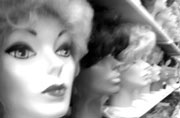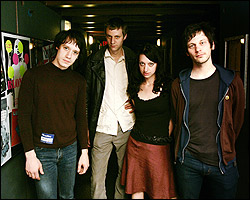All the pictures we have of my Grandma Eileen in her prime feature her in a gracefully obedient ash-blond bouffant wig and jeweled black cat-eye glasses. Eileen was very stylish, and she liked nice things. As my friends and I round the corner onto Second Avenue, artfully dodging a slowly shuffling junkie with about an inch and a half of ash suspended from the end of her cigarette, I’m thinking that Grandma Eileen probably would not have been so hot on this neighborhood. But just past the littered parking lot and a clinic offering free hepatitis screenings is Wig Land, and as soon as we’re inside, I’m thinking that Eileen would definitely like it in here just fine.
The walls of Wig Land are lined with wigs. Shelves and shelves of wigs on wig heads; shelves from the floor to the ceiling. Short, curly wigs on dark plastic wig heads; long blond wigs on pale plastic wig heads; and smart, gray wigs on washed-out yellow wig heads that would appear to be sick with jaundice. There are wigs that have been made in the same style since 1960, and there are wigs made to mirror this year’s Grammy winners. So many wigs, really, that we don’t really know where to begin. Enter Paul Jun.
Wig Land has been a part of Jun’s family for over 30 years. He gets referrals from the American Cancer Society and from local hospitals, but the majority of his customers are grandmothers, theater groups, tourists, drag queens, and the comfortably vain.
When I ask if he’s ever thought of moving to a better neighborhood, he just shakes his head and smiles, insisting that the riffraff at the nearby methadone clinic doesn’t bother him. He reports that his biggest problem are the greasy-haired teenagers who come in just to waste time. Luckily, we’re all safely past our teens, so Jun pulls out a few of the black nylon head socks that are worn over your real hair and under the wig, and the pointing begins.
TURNS OUT MOST wigs are one size, although most employ some variety of hook-and-eye or Velcro fixture so that the fit may be rendered snug and secure. Jun also tells me that most wigs are made using two distinct cranium forms—one for African- American heads and one for Caucasian. When I express concern that all the world’s heads might not fall into those two categories, Jun corrects himself a bit by saying that the Caucasian form is better described as “multipurpose” or “other.” Understood. The girls and I will pick from the catchall collection.
We select a wavy blond flip; a short, spiky ’80s shag; a few long brunettes—one with bangs and two without; a red Cleopatra; a theatrical Louis XIV; a severe black bob that will prove too harsh; and an oddly-hued thing that looks like what Bo Derek would’ve worn had she landed Uma Thurman’s role in Pulp Fiction. We skip the over-the-top afros and the unflatteringly colored “punk rock” mullets.
Jun gingerly places a black head sock over each of our heads and then, even more carefully, comes the first wig.
Almost instantly, my ash-blond friend becomes Monica Lewinsky—only way, way hotter. Her blue eyes are bluer, her faded tan becomes exotically olive, and she appears to be, quite literally, feelin’ it. She jumps up instantly and poses in front of the mirror as if to see what her butt looks like as a brunette with long layers and shaggy bangs. Satisfied but suddenly hungry for more hair, she pulls it off and is on to something red.
Jun slides Cleopatra (from the Viva collection, $50) over her black-socked head and then whips out a pocket brush and begins to style. The wigs transform Mr. Jun a bit, too; he’s now as much a Midwestern hairstylist as he is a typical downtown store owner. I ask him how he and his family got into the wig business, hoping he’ll tell me some romantic story that stretches back to his native Korea. Instead he tells me that his mother-in-law’s brother had a successful wig store in New Jersey, and they figured if it could fly there, why not in Seattle? All these years later, Wig Land moves about 170 wigs every month. I ask him how he decides what styles to carry, and he says the dozen or so wholesalers he deals with advise him as to their best sellers and, on occasion, he just goes with his whim. As if remembering a few bad decisions, Jun smiles shyly and reports that he likes to keep it simple. Turning my head up to face the walls of blank, painted-on smiles, I’d say his assortment is anything but.
When it’s my turn, Jun skips the wigs we’ve selected and takes down one of the Cadillac models—a real human hair, meticulously-crafted upper-tier number called, quite plainly, Jenny. You’d think for 120 bucks, the folks at Integra Wigs (Integra?) would go for the more sophisticated “Jennifer,” but once the hair is on, I’m over the details. You get what you pay for—in wigs as in most things—and now I can’t stop daydreaming that I’m Cybil Shepherd in The Last Picture Show. This thing looks good. And then I notice my once-blond, now redheaded friend turning over the price tag of her wig and doing some mental calculations. I think Jun’s got a sale.
“You look nice in that,” Jun tells her. And I picture Grandma Eileen, who always liked nice things, nodding her bouffant in agreement.









